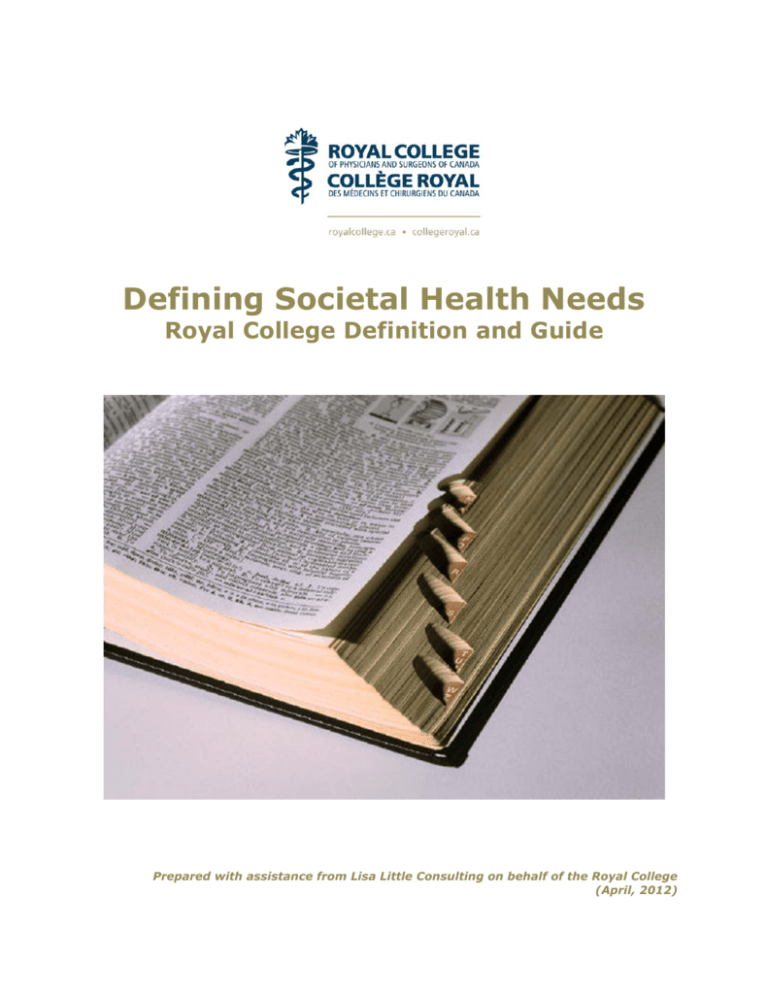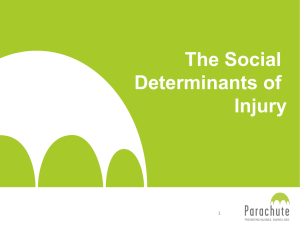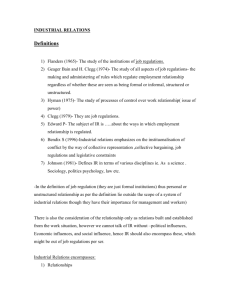
Defining Societal Health Needs
Royal College Definition and Guide
Prepared with assistance from Lisa Little Consulting on behalf of the Royal College
(April, 2012)
Introduction
The Royal College’s programs and policies have long stated its intention to be responsive to
societal health needs. For example, the CanMEDS Framework which was originally adopted
in 1996 was explicitly developed with that purpose in mind. More recently, the Royal
College’s strategic plans aim to ensure that specialty medicine meets society’s health needs.
There are disparate approaches to defining societal health needs in the literature and in the
health system. Definitions or models may be framed around values, based on various types
of social determinants, by demographic dimensions or data-based such as incidence and
prevalence.
Without a clear, Royal College-specific definition, the Royal College has been hampered in
setting a comprehensive, integrated approach and path for its programs and policies.
Purpose
The purpose of the Societal Health Needs definition is to provide common, cohesive and
pertinent concepts, definitions and approaches to help ensure greater overall alignment of
the Royal College’s, policies, positions, programs and standards, and promote transparency
of its decision making to various stakeholders and partners. The Guide and associated tools
is designed to support the application of the definition by the various committees of the
Royal College. The Council will also be better positioned to assess progress against the
elements of the strategic plan that contribute to societal health needs.
Approach
The definition is derived from a literature synthesisi completed on the topic of ‘societal
health and wellness needs’. A draft definition underwent consultation within the Royal
College and its various committees and was modified to reflect the feedback. The definition
is subject to Council approval at its next meeting in June 2012.
The Guide, partly based on the “Social Justice Gauge tool” developed by the Canadian
Nurses association1, provides a proposed process to integrate the concept of societal health
needs in all facets of Royal College work. This guide, which will be refined with use, is
therefore an evergreen document. The guide contains the following:
General Instructions: This section describes the proposed series of steps to assess
policy documents and other actions to ensure they reflect societal health needs.
Decision Aid: This assessment aid is comprised of questions, key considerations, and
relevant resources for each component of the definition to help determine alignment.
Decision Grid: The purpose of the grid is to document the observations from each
part of the assessment.
1
Social Justice…a means to an end, an end in itself. (2nd ed.) Canadian Nurses Association (Nov. 2010).
http://www2.cna-aiic.ca/CNA/documents/pdf/publications/Social_Justice_2010_e.pdf
2 Definition
Societal health needs are the requirements at the individual, family, community and
population levels-across the continuum of care-to achieve physical, cognitive, emotional,
social and spiritual wellbeing, taking into account the broad determinants of health.
Description
The requirement for health and social services occurs within a model of health system
design influenced by an ethical, economic, social, technological, geographical, multicultural,
and political context where:
“Societal” implies that health is examined at an individual, community and population
level reflecting local, community and global environments. A population centered
approach to need is one that:
embraces an epidemiological approach;
focuses on the needs of all individuals, communities and populations – from
privileged to disadvantaged –
to reduce health and social disparities and
promote health and health equity;
embraces community orientation, engagement and involvement
“Health” is holistically defined as a state of complete physical, cognitive, emotional,
social and spiritual wellbeing and not merely the absence of disease or infirmity, within a
cultural context. As such it incorporates the determinants of health.2
“Need” is defined as the gap between a current and a desired state of being. Needs can
be objective (measured) or subjective (perceived) and physical or psychological.
Recognizing that needs change over time, they are identified through a collaborative
process that is patient-centered, culturally sensitive, evidence-based or informed, and
outcomes directed. Within the context of this approach, needs are identified by
combining: information on the health status of the population, demographics and
appropriate standards or levels of care.
The continuum of care includes illness prevention and health promotion, public health,
screening, diagnosis, acute care (primary, secondary, tertiary and quaternary), chronic
disease management, rehabilitation, long term care, survivorship and palliative care.
2
income and social status; social support networks; education employment and working conditions; social
environments; physical environments; health literacy, biology and genetic attributes; epi-genetics; personal health
practices and coping skills; healthy child development; racism and social exclusion; and health services. Additional
Aboriginal–specific health determinants include self-determination; social capital, access to health care; cultural
continuity, environmental stewardship, economic development; residential school syndrome, and colonization. 3 Application Guide
General Instructions
The Application Guide and its associated tools are based partly on the “Social Justice Gauge
tool” developed by the Canadian Nurses Association for assessing policy documents and
position papers for alignment as they advance national and international health policy and
development in Canada and abroad to support global health and equity. 1
The Application Guide will identify areas that need to be strengthened to be in better
alignment with societal health needs, as well as identify existing strengths in a policy,
program or specialty. The key considerations are not necessarily applicable to all situations,
but rather provide a range of possible points of reflection.
The Application Guide can be used by individual members of a committee; it can also be
completed in a group process by a committee as a whole.
The Application Guide involves a four-step process:
Step 1: Identify the program, policy or other ‘product’ such as practice, standard,
principles, proposal, or specialty application under consideration.
This may include
obtaining a description and any related material.
Step 2: Consider the specific program, policy, or product in relation to each of the questions
and key considerations as part of the decision aid called Assessment Alignment. This
involves responding to each of the six questions. Each question includes key considerations
and link to resources to further assist in the decision making process. Responses might
include ideas, and facts as well as examples. When providing examples, users are
encouraged to include details, values or directions, the use of particular tools or methods
Step 3: Using the second decision aid called Assessment Grid, summarize findings
highlighting strengths and areas that need to be strengthened to better align the policy,
program or product with the definition of social health needs.
Step 4: Make any necessary changes to the policy, program or product.
4 Decision Aid – Assessment Alignment
1. Does it acknowledge that the requirement for health and social services
occurs within a model of health system design influenced by an ethical,
economic, social, technological, geographical, multicultural, and political
context?
Possible Considerations:
What are the key contextual drivers of the need for the policy, program or product?
o
Ethical considerations, i.e. end of life care
o
Economic situation , i.e. cuts to specific health programs
o
Social trends, i.e. aging population
o
Technological advances ,i.e. nanotechnology
o
Geography, i.e. urban vs rural, distribution
o
Cultural influences or differences, i.e. diabetes rates of Aboriginal people
o
Political, i.e. health goals/targets defined by provincial/territorial government
Resources:
Advisory Committee on Health Delivery and Human Resources. (2007).
“Framework for collaborative pan-Canadian health human resources
planning”. Ottawa: Health Canada.
Health System and Health Human Resources Planning Conceptual Framework
5 2. Does it acknowledge/incorporate that health is examined at an individual,
community and population level reflecting local, community and global
environments?
Key Considerations:
Is the policy, program or product applicable to an issue that is relevant to
people living in specific communities, regions, across Canada or
internationally?
Does the policy, program or product incorporate an epidemiological approach?
Does the policy, program or product identify actions to address the needs of
disadvantaged populations? Of Aboriginal people?
Does the policy, program or product include actions to address health and
social disparities?
Does the policy, program or product promote health equity?
Does the policy, program or product embrace community orientation,
engagement and involvement?
Canadian Institutes of Health Research
Resources:
The Population Health Template: Key Elements and Actions That Define A
Population Health Approach
6 3. Does the policy, program or product define health holistically as a state of
complete physical, mental (cognitive/emotional), social and spiritual
wellbeing and not merely the absence of disease or infirmity, within a
cultural context, incorporating the determinants of health?
Key Considerations:
Is health defined holistically within the policy, program or product?
Are the contributing determinants of health well defined?
Are there implications relative to the cultural context? i.e. residential school
syndrome for Aboriginal people
Source: Health Canada, “Health and Environment: Critical Pathways,” Health Policy Research Bulletin,
Issue 04, October 2002, p. 3.
Resources:
Determinants of Health, Public Health Agency of Canada
Determinants of Health, World Health Organization
Social Determinants of Métis Health
Broader Determinants of Health in an Aboriginal Context
National Collaborating Centre for Aboriginal Health Determinants of Health
Fact Sheet Series
7 4. Does it define ‘need’ as the gap between a current and a desired state of
being, recognizing that needs change over time, are identified through a
collaborative process that is patient-centered, culturally sensitive,
evidence-based or informed, and outcomes directed?
Key Considerations:
Are the needs focused on that of the patient as opposed to the provider?
What are the contributing factors to the needs?
Was a cultural context applied to the definition/calculation of need?
What is the evidence base for the definition/calculation of the need for the
policy, program or product?
Does the definition/calculation of need include a specific goal or outcome? Is
it linked to national or provincial/territorial health goals or specific health
outcome or system performance targets? i.e. wait time target, disease
prevalence target, etc.
Resources:
Final Report: Ontario Population Needs-Based Physician Simulation Model
Geographic Distribution of Physicians in Canada: Beyond How Many and
Where
Health system performance data available at the Canadian Institute for
Health Information
8 5. Does it acknowledge needs can be objective (measured) or subjective
(perceived) and physical or psychological? Within the context of this
approach, needs are identified by combining: information on the health
status of the population, demographics and appropriate standards or levels
of care.
Key Considerations:
How is the need identified? (objective or subjective)
What process has been taken to identify the need?
Is the process to identify the need evidence based?
Does it measure need over time?
Does it show an increasing need or constant over time?
Is this need currently able to be met by another provider?
What is the estimated size of the population with this need?
What is the geographic distribution of need?
How is the health status of the target population determined?
i. What indicators or measures are used?
ii. Are there national sources of data to support the identification of
need?
Are there particular standards of care or level of care that would are core to
addressing this need?
Are there clinical practice guidelines specific to address this need?
What would be the health outcome goals for the population expressing this
need?
Resources:
Final Report: Ontario Population Needs-Based Physician Simulation Model
Human Resource Planning and the Production of Health: A Needs-Based
Analytical Framework
Demography data available at Statistics Canada
Population health data available at Statistics Canada
Aboriginal people data available at Statistics Canada
Population health data available at the Canadian Institute for Health
Information
9 6. Does the policy, program or product acknowledge/incorporate illness
prevention and health promotion, public health, screening, diagnosis, acute
care (primary, secondary, tertiary and quaternary), chronic disease
management, rehabilitation, long term care, survivorship and palliative
care?
Key Considerations:
Is it applicable across the continuum of care or at least multiple practice settings?
What settings specifically?
Is there an illness prevention and health promotion component that is unique?
Are there unique screening tools identified?
Resources:
Canadian Partnership Against Cancer - Cancer Control Continuum
Continuum example from the Canadian Partnership Against Cancer’s web site: http://www.partnershipagainstcancer.ca/about/who-we-are/
10 Decision Aid – Assessment Grid
Royal College of Physicians and Surgeons of Canada
Societal Health Needs Application Guide
Assessment
1. Does it acknowledge that the
requirement for health and
social services occurs within a
model of health system design
influenced by an ethical,
economic, social, technological,
geographical, multicultural, and
political context?
Yes No
Comments:
2. Does it
acknowledge/incorporate that
health is examined at an
individual, community and
population level reflecting local,
community and global
environments?
Yes No
Comments:
3. Does it define health holistically
as a state of complete physical,
mental, social and spiritual
wellbeing and not merely the
absence of disease or infirmity,
within a cultural context,
incorporating the determinants
of health?
Yes No
Comments:
4. Does it define ‘need’ as the gap
between a current and a
desired state of being,
recognizing that needs change
over time, are identified
through a collaborative process
that is patient-centered,
culturally sensitive, evidencebased or informed, and
outcomes directed?
Yes No
Comments:
Action(s)
11 5. Does it acknowledge needs can
be objective (measured) or
subjective (perceived) and
physical or psychological?
Within the context of this
approach, needs are identified
by combining: information on
the health status of the
population, demographics and
appropriate standards or levels
of care
Yes No
Comments:
6. Does it acknowledge/
incorporate the continuum of
care includes illness prevention
and health promotion, public
health, screening, diagnosis,
acute care (primary,
secondary, tertiary and
quaternary), chronic disease
management, rehabilitation,
long term care, survivorship
and palliative care?
Yes No
Comments:
Findings:
Copyright © (2012) The Royal College of Physicians and Surgeons of Canada. All rights reserved.
This material may be reproduced in whole or in part for educational, personal or public non-commercial purposes
only. Written permission from the Royal College is required for all other uses.
12






